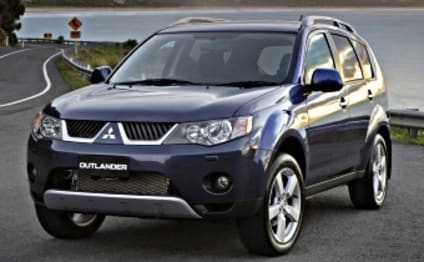
Mitsubishi Outlander 2007 Review
- Mitsubishi Outlander
- Mitsubishi Outlander 2007
- Mitsubishi Outlander Reviews
- Mitsubishi Reviews
- Mitsubishi SUV Range
- SUV
- Mitsubishi

The crossover wagon is the first of a new fleet of Mitsubishi models casting light on the Japanese company's dark times.
The previous all-wheel-drive Outlander arrived in Australia in 2003, but didn't make much impact. It didn't do anything better than its rivals and it looked awkward.
Then there was the fact it had only a four-cylinder engine, unlike rivals such as the Mazda Tribute with an option of four or six.
Mitsubishi learned a lesson and developed a new model that is larger, has the choice of a four or six-cylinder and can be ordered with seven seats. It is also much easier on the eye.
The four-cylinder engine is the familiar 2.4-litre MIVEC with 125kW and 226Nm.
It has continuously variable automatic transmission. The V6 is a 3.0-litre with 162kW and 276Nm, linked to a six-speed automatic. There is no manual option for either engine.
The four-cylinder's official fuel economy figure is 9.5 litres for 100km of city and highway driving; the six is 10.9 litres.
Both Outlanders have a standard AWD system, which the driver can electronically control. It can run in two-wheel-drive mode, which means the engine feeds power only to the front wheels and saves fuel.
In automatic mode, the drive is sent through the front wheels, but will switch into AWD mode if the drive wheels start to slip.
Then there is constant AWD mode, which means the car feeds power to all four wheels.
The new Outlander is larger than the previous model, which competed with the Toyota RAV4 and Honda CR-V, but still smaller than models such as the Ford Territory.
Four models make up the range and all can be ordered with five or seven seats.
The range starts with the LS five-seater at $31,990.
It is standard with airconditioning, cruise control, steering-wheel-mounted audio controls, roof rails and a trip computer. It has 16-inch steel wheels.
Standard safety gear for the LS includes anti-skid brakes and driver and passenger airbags. Side airbags cost an extra $1500. Electronic stability control is unavailable on four-cylinder models.
The $37,490 XLS four-cylinder adds 18-inch alloy wheels, tinted windows, paddles shifters, climate-control airconditioning, six-CD stacker, rear-parking sensors, fog lights, Bluetooth phone preparation, cargo cover, a chilled storage box and keyless entry.
The V6 range starts with the $37,890 VR model, which has the same gear as the LS but adds paddle-shift transmission control, traction control and electronic stability control, tinted windows and twin exhausts. Top of the range V6 VRX costs $43,190 and comes with the same equipment as the XLS, plus side-curtain airbags, traction control, electronic stability control, premium sound and twin exhausts.
Adding a third row of seats costs $2800 for the LS and VR models and $4050 to $4800 for the XLS and VRX, which also have a rear-seat entertainment unit.
All models have a space-saver spare tyre and the towing capacity is 1500kg for the four and 1600kg for the V6.
ON THE ROAD
YOU could be forgiven for thinking the new Outlander simply follows on from the first model, but it really is so fresh Mitsubishi could well have justified changing the name.
It now feels more car-like, is roomier, has more power and looks better.
There are some minor issues, but this is an impressive car.
The four-cylinder engine is adequate and works well enough with the continuously variable transmission, but the new V6 is the best choice if you can afford it.
The six has plenty of punch and is fairly smooth.
It works well with the new automatic transmission that has a tall top gear.
That means the engine is at 1600 revs when the car is doing 100km/h, which is better than one that buzzes along.
Even so, the V6 is fairly thirsty despite having six cogs to choose from and the test car rarely dips below 10 litres for 100km and often creeps to 13 and 14 litres/100km around town.
It's not a sporty-sounding engine, but doesn't sound unpleasant either. Tyre and road noise on several surfaces including coarse chip tarmac is a problem and spoils a nice drive.
It almost seems that someone has forgotten to fit some of the sound-proofing.
Most time of the time was spent in a V6 VRX, with 18-inch wheels, which handles country roads well.
The suspension is not troubled by a bumpy test route and feels well tied down and has limited body roll.
The Outlander sits low to the ground and feels more car-like but with a slightly higher driving position than an AWD wagon.
It might have paddle-gear shifts, but no one is going to mistake the Outlander for a sportscar especially with woolly steering that doesn't encourage you to push.
The AWD system, when locked in, works well on gravel.
Most families will appreciate the extra space and the improved interior.
The optional two extra seats are next to useless because the bases have no padding.
The second row of seats fold easily, but the third row is clumsy and hard to move.
The other downside is the lack of a full size spare, which should be standard.
Pricing guides
Range and Specs
| Vehicle | Specs | Price* | |
|---|---|---|---|
| LS | 2.4L, ULP, CVT AUTO | $5,940 – 8,360 | 2007 Mitsubishi Outlander 2007 LS Pricing and Specs |
| VR | 3.0L, ULP, 6 SP AUTO | $5,060 – 7,480 | 2007 Mitsubishi Outlander 2007 VR Pricing and Specs |
| VR-X | 3.0L, ULP, 6 SP AUTO | $6,930 – 9,790 | 2007 Mitsubishi Outlander 2007 VR-X Pricing and Specs |
| XLS | 2.4L, ULP, CVT AUTO | $4,950 – 7,260 | 2007 Mitsubishi Outlander 2007 XLS Pricing and Specs |
$2,999
Lowest price, based on 16 car listings in the last 6 months







